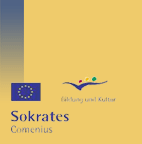|
Preparation:
cups, round paper filters with a hole in the centre (laboratory
equipment), rectangular pieces of filter, water-soluble (black and other
dark) felt pens, water, clothes-line and clothes-pegs for hanging up the
coloured sheets of paper
Building instructions for a wick:
A rectangular piece of filter paper is put through the hole in a round
filter, then the construction is put into a cup half-filled with water so
that the wick reaches the water.
|
Steps:
The children are confronted with a filter painted black and another
one with coloured lines, and with the statement that the coloured filter at
first looked like the one painted black.
They search for an explanation, paint filters and expose them to
different external influences.
They see that when you carefully add humidity other colours develop
out of the black colour. In order to measure out the amount of humidity that
is to be added, they build a paper wick (see left column).
|
|
Scientific Explanation:
The colour black is composed of different colours. When the capillary
effect makes the water rise in the paper wick and spread through the painted
filter, some components of the black colour will be washed out quickly, while
others are held more strongly by the paper.
|
Possible Variation:
The children experiment with other colours, and see into which colours
these can be split up.
|











